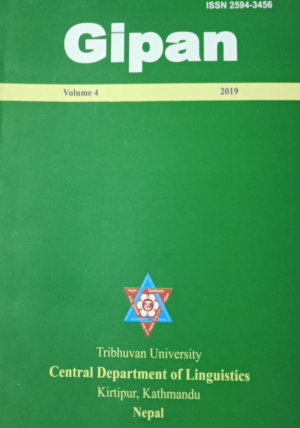Segmental phonological properties in Thakali: a typological perspective
DOI:
https://doi.org/10.3126/gipan.v4i0.35463Keywords:
aspirated, murmered, retroflex, cluster, syllable, typologicalAbstract
Thakali, a Tibeto-Burman language spoken in Nepal, exhibits some typologically interesting properties in the domain of segmental phonology. It presents a rich inventory of 33 segmental consonant phonemes and a set of six monophthongal vowels with murmured voice (i.e., breathy) counterparts. The syllable structure at the maximum consists of (C) (X) V (C), where X stands for a glide or liquid phoneme. Thakali as a Bodish language contains retroflex series as well as distinct alveolar fricatives and affricates and lacks phonemic voicing contrasts. As a member of the Gurungic cluster of West Bodish sub-section, Thakali shares such properties with other West- Bodish languages, viz., Chantyal, Manange, Gurung, Magar Kaike, Ghale, Seke, Nar-Phu, Western Tamang and Eastern Tamang. Unlike a Bodish language, Thakali lacks phonemically nasalized vowels. Thakali, like Chantyal, presents contrasts involving voice onset time and murmur. Such contrasts are attested in stops, affricates, fricatives, trills/taps and laterals in Thakali. However, unlike Chantyal, Thakali contains murmured trill/tap and murmured lateral with voiceless onset like Seke and Nar-Phu. Such properties are exclusively absent in other West Bodish languages. While uplifting Thakali, a shifting language, from sustainable identity to sustainable orality, such properties typical in South Asia (Noonan, 2003a: 316) have to be fully maintained.
Downloads
Downloads
Published
How to Cite
Issue
Section
License
This license enables reusers to distribute, remix, adapt, and build upon the material in any medium or format for noncommercial purposes only, and only so long as attribution is given to the creator.

